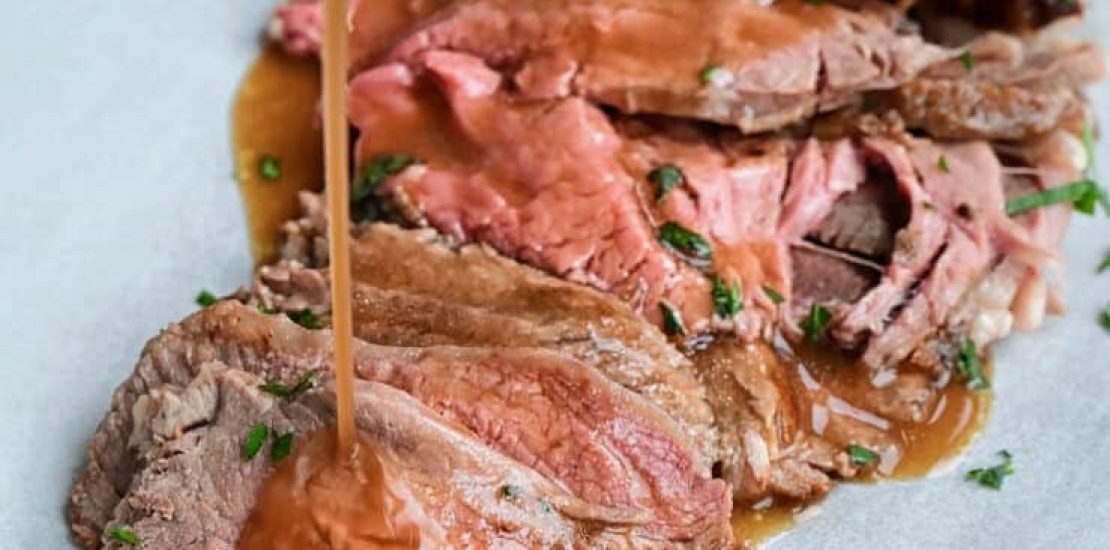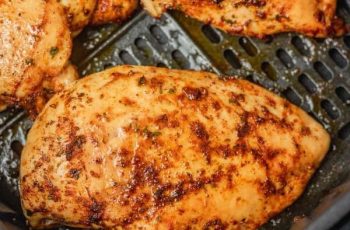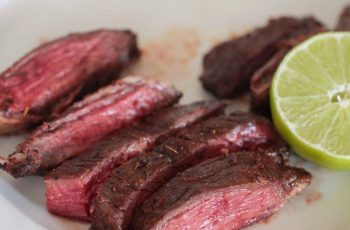Air frying a prime rib can result in a flavorful and juicy roast with a crispy exterior. Here’s a basic recipe and some notes to help you achieve the best results:
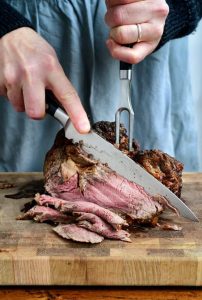
Ingredients:
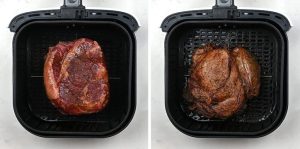
- Prime rib roast (size and quantity as desired)
- Olive oil
- Salt and pepper
- Your choice of herbs and spices (rosemary, thyme, garlic powder, etc.)
Instructions:

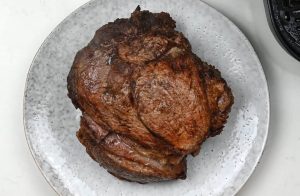
- Preparation:
- Remove the prime rib roast from the refrigerator and let it come to room temperature for about 1-2 hours before cooking. This helps ensure even cooking.
- Seasoning:
- Rub the roast with olive oil to help the seasoning adhere and promote browning.
- Season the roast generously with salt, pepper, and any herbs or spices of your choice. Press the seasoning into the meat to help it stick.
- Preheat the Air Fryer:
- Preheat your air fryer to around 375°F (190°C). The exact temperature may vary based on your air fryer model, so consult the manufacturer’s instructions.
- Air Frying:
- Place the seasoned prime rib roast in the air fryer basket, fat side up. Make sure there’s enough space around the roast for air circulation.
- Cook the roast at the preheated temperature. Generally, for medium-rare prime rib, cook for about 20-25 minutes per pound (45-55 minutes per kilogram). Cooking times can vary, so it’s best to use a meat thermometer to ensure the desired doneness.
- Checking Doneness:
- About halfway through the cooking time, pause the air fryer and use a meat thermometer to check the internal temperature. For medium-rare, aim for around 130-135°F (54-57°C). Remember, the temperature will rise a few degrees as the meat rests.
- Resting:
- Once the prime rib reaches your desired doneness, carefully remove it from the air fryer and place it on a cutting board. Cover the roast loosely with aluminum foil and let it rest for about 15-20 minutes. This allows the juices to redistribute and ensures a juicy result.
- Slicing and Serving:
- After resting, slice the prime rib into your desired thickness. Serve with your favorite sides and enjoy!
Notes:
- Size Matters: Adjust the cooking time based on the size of your prime rib roast. The thickness of the roast can affect cooking time. Using a meat thermometer is crucial to achieving the perfect doneness.
- Meat Thermometer: A reliable meat thermometer is your best friend when cooking any type of meat. Insert the thermometer into the thickest part of the roast without touching the bone to get an accurate reading.
- Crispy Exterior: The air fryer can provide a nice crispy exterior, but don’t expect the same level of crust as you would from an oven-roasted prime rib.
- Experiment with Seasonings: Feel free to get creative with your choice of herbs and spices. You can also create a flavorful rub or marinade to enhance the taste.
- Safety First: Always follow the safety guidelines and recommendations provided by your air fryer’s manufacturer.
Remember that air fryer models can vary, so it’s a good idea to consult your specific air fryer’s manual for any additional guidance on cooking times and temperatures.
Certainly, here are some additional tips and considerations to keep in mind when air frying prime rib:
- Trussing the Roast: Trussing involves tying the roast with kitchen twine to help it maintain its shape during cooking. While this isn’t strictly necessary for air frying, it can help the roast cook more evenly and present a more uniform appearance.
- Marinating: You can marinate the prime rib before cooking to infuse it with additional flavors. However, if you choose to marinate, make sure to pat the meat dry before air frying. Excess moisture can hinder the browning process.
- Air Fryer Size: The size of your air fryer basket will determine how large a prime rib you can cook at once. Avoid overcrowding the basket, as this can lead to uneven cooking. If you have a large roast, you might need to cut it into smaller portions to fit.
- Basting: While air frying, you might consider basting the roast with its own juices or melted butter to enhance flavor and moisture. Just be careful not to open the air fryer too frequently, as this can affect the cooking process.
- Resting Time: The resting period after cooking is crucial for allowing the meat’s juices to redistribute. This results in a juicier and more tender prime rib.
- Accurate Temperature Reading: When using a meat thermometer, make sure the probe isn’t touching any bone, as this can give you an inaccurate temperature reading.
- Customizing Flavor: Beyond basic seasoning, consider experimenting with different spice blends, herb combinations, and even rubs to create a unique flavor profile that suits your taste preferences.
- Serving Suggestions: Prime rib is often served with horseradish sauce, au jus, or a flavorful gravy. These accompaniments can enhance the dining experience.
- Practice Makes Perfect: Air frying a prime rib might require a bit of trial and error to get the timing and results just right. Keep notes of your cooking times, temperatures, and adjustments for future reference.
- Food Safety: Ensure that the prime rib reaches a safe internal temperature for consumption. While medium-rare is around 130-135°F (54-57°C), the USDA recommends a minimum internal temperature of 145°F (63°C) for whole cuts of beef.
Remember that cooking times can vary depending on factors such as the starting temperature of the meat, the air fryer’s performance, and the desired level of doneness. It’s a good idea to have a meat thermometer on hand and to monitor the roast’s internal temperature closely to achieve the perfect results.
